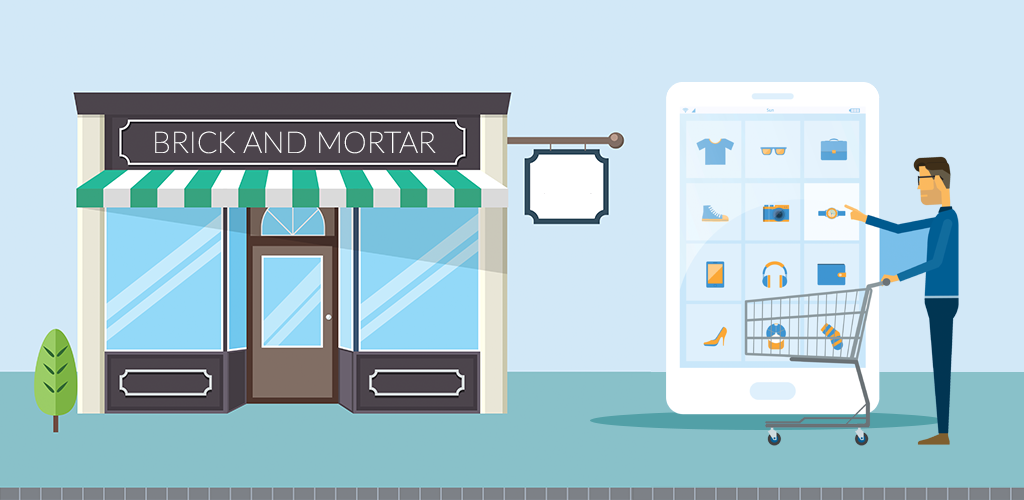But first, what is commerce?
Commerce, the method of buying and selling goods (not the other definition..) has been around since, well.. We really don’t know. All of known human history we have bought, made, sold, and traded all over the world. From the 4000 miles of the silk road to the birth of the garage sale, we humans have bartered our goods in many different ways over the years to our respected customers. Apart from the traveling merchant, the most popular sales method in the past “while” has been selling your wares through a brick-and-mortar store, so what’s that all about?
What are Brick-and-Mortar stores?
Short and sweet – Any business with a physical location that customers can view and purchase goods and services from would be termed a “brick-and-mortar” store. Your local supermarket, the Nike store in the mall, or Supercheap Auto would be classed as such.
What are E-commerce websites?
Any sales based website that customers can purchase from is classed as an e-commerce website. Different from a brick-and-mortar store, the e-commerce website utilises electronic commerce technology and doesn’t always have a physical store that consumers can purchase from. Keep in mind, some businesses operate both e-commerce websites and brick-and-mortar stores to harness the best of both worlds.
As of recently, e-commerce websites are fast increasing in popularity and accounted for 4.9 Trillion dollars (USD) worth of retail sales worldwide in 2021. Because of this they become a serious top contender for retail sales methods out there.
The ‘E-commerce-brick-and-mortar hybrid thingy’.
As technology has grown over the years, it’s helped combine these two selling methods together. In 2018, Amazon opened its first cashierless store which leverages smart electronic commerce technology but in a brick-and-mortar store environment. Customers walk in, put items in their basket, and walk out without having to do anything other than that. The store tracks their choices and automatically charges their card when they leave the store. We won’t cover much more on this hybrid of the two but hopefully it’s given you a feeling of where things are heading.
So, what are the benefits of a physical store?
Physical interaction.
A huge benefit to brick-and-mortar stores is that their customers can physically interact with the product. This lessens the possibility of disappointment because the customers see exactly what they are getting. It also can push customers closer to conversion considering the product they want is right there.
This extends past the physical products themselves. Some customers prefer to talk to people face-to-face or may suffer from ‘technoidontknowwhatimdoingism’. On the flip side some customers would rather not have that human interaction at all which is something that has blown up after the Covid pandemic. This poses a benefit and a disadvantage to brick-and-mortar stores.
Product availability.
Some things just can’t wait. For example, you’ve lost your phone charger cable, forgotten to buy chocolate for the misses, or you’re one fence paling short from finishing the day with a beer.
Unless an e-commerce store offers same day delivery which unfortunately is still held to the possibility of delays, you’d probably prefer to just pop down to the shop and pick out whatever you need. Fingers crossed they have it in stock though.
Easier decisions.
One thing that brick-and-mortar stores have over e-commerce websites is their limited range can make consumers purchasing decisions easier. Psychological studies have shown that while we humans like choice, the more choice we have actually limits our ability to choose. Less is more. A saying that’s even baked into UX website design techniques, just check out Google’s home page for example.
When you’re in a store you might only be subjected to a few different brands with their own individual options. When you’re online, it can be harder for some consumers to find exactly what they need due to the sheer ‘Google-load’ of options out there.
The benefits of an e-commerce website.
E-commerce websites have low operational costs for great returns.
Of course, any e-commerce website will have operating costs but they are drastically less than that of a brick-and-mortar store, giving you a great return on your investment. You need less staff, you don’t need to rent or buy a shop, even creating or updating an e-commerce website is cheaper than creating a storefront. Think about all the operating costs you’d save on. Better yet, you could even drop your prices while retaining the same profit to get an edge on your competitors.
Digital advertising and e-commerce websites go hand in hand.
It’s pretty understandable that they would, right? If you’re going to advertise something online, what better to advertise than your e-commerce website. Even better, the products or promotions you have on that e-commerce website. No other advertising method puts customers closer to conversion than literally being a click away. Well, you could chant your sales pitches outside your shop hoping people will come in but even that misses out.
One of the greatest tools out there that businesses can take advantage of nowadays is digital advertising. Compared to other methods, it’s cheap for the coverage you get, it’s highly targetable, it’s accurate, and (My favourite) it’s testable with live feedback. I wrote a piece on 9 tools you should check out to help your business that I’ve linked here if you want to read more about digital advertising. [INSERT LINK FOR 9 TOOLS FOR YOUR BUSINESS HERE]
E-commerce websites are open 24 hours a day, 7 days a week.
E-commerce websites are a tireless sales person, bright-eyed singing your story and selling your goods at 3 in the morning to those couple of night owls that are craving a bit of retail therapy. You’re probably not going to hop out of bed and drive down to your shop that early to serve those customers. That’s why you should let an e-commerce website do it for you. You can keep up with your beauty sleep and arrive at work with a pleasant surprise of sales!
Let’s say you’re open from 8am till 5pm Monday to Friday and 9am till 5pm on Saturdays, that’s 53 hours a week. An e-commerce website is open 168 hours a week.. Think of how many more sales an e-commerce website could make you!
Reach customers close and far with an e-commerce website.
With an e-commerce website you’re not limited to your local customers, you’re not even limited nationally. Customers all over the world can find your business on the web and purchase your goods. E-commerce websites can turn your business into an international servicer. Just think about how cool it would be knowing someone in Finland is eating your locally made honey? Or that someone from Hawaii is wearing your latest t-shirt drop? An e-commerce website makes it easier for you to sell internationally and easier for those international customers to purchase.
E-commerce websites can harness customer data.
The subject of user data seems to be the talk of the town since users are finding out a lot of companies they subscribe to are selling their data. Frankly, it’s put a bad reputation on the word but the use of consumer data doesn’t have to be as nefarious as how some companies are using it. Collecting and analysing consumer data can be unintrusive, it can also be an amazing tool for understanding your customers to improve your offerings, find customer pain points, and grow your business.
E-commerce websites are one of the best types of websites for collecting this data and as I said, it doesn’t have to be intrusive. You can build buyer profiles and identify who wants what and at what price with just a simple account sign up. That way you know the best items and deals for the best people. Remember, you should be helping them out in return for this data transaction. Don’t take advantage of consumers trust.
E-commerce websites can scale with your business as grows.
The great thing about e-commerce websites is that they can scale with your business as it grows, or it can scale to grow your business! Using tools such as Google Analytics can give you insane insights into the ‘who’ your consumers are and the ‘how’ they’re using your e-commerce website. This information can be used as a roadmap to grow your website’s usability, to increase its conversion rate, to build your brand awareness, and even target a new customer base for example. This leads into my next spiel..
Just like stores, e-commerce websites can be set up to convert.
Having multi-buys on the counter or directing your customers past all the impulse buy deal bins when they leave the store has been a great way to increase your basket size. E-commerce websites do a great job of this as well. An e-commerce website that’s set up correctly and leverages proper UX and UI design techniques to push those customers closer to conversion is a deadly sales weapon any business would love.
You might see an e-commerce website as nothing more than just.. Well, a website. It’s better to imagine it as a brick-and-mortar store. From the moment you land on that website, it’s taking you on what marketers would call a ‘sales funnel’ journey. Directing you here, catching your eye there, pushing you closer to its end goal. What’s the end goal? That’s really up to you. E-commerce websites can be set up in thousands of ways to reach the best outcome for you.
So who wins out of this ‘e-commerce website vs brick-and-mortar store’ battle?
Truth be told, it depends!
Ha, thought I was going to outright say e-commerce websites after harping on about it for so long? Nope. It really does depend. Different business models call for brick-and-mortar stores over e-commerce websites, just as they can the opposite way too. E-commerce is great for those first venturing out into the business world with their ideas because of its lower set up fees, its feedback, and potential growth to help them get kick started. Others need that physical location for their customers to visit.
It’s actually very beneficial for businesses to consider covering both of their bases and running both side by side. Not all of your customers are going to want to come in store, some do. Not all customers know how to use the internet, others can’t get enough. Not all customers are free during daylight opening hours, some are. Utilising both an e-commerce website and a brick-and-mortar store means you’re reaching both of these customers to harness the most of the market that you can.
Thanks for having a read, I hope this article has shed some light on the subject. Brick-and-mortar stores aren’t exactly our speciality at Builtflat but luckily e-commerce websites are. Not only do we understand the challenge behind setting one up, we know how to build it properly to start converting from the get-go. So if you’re interested or even just have any website development questions you can contact us [INSERT LINK TO CONTACT PAGE] here, we’d love to hear from you!

